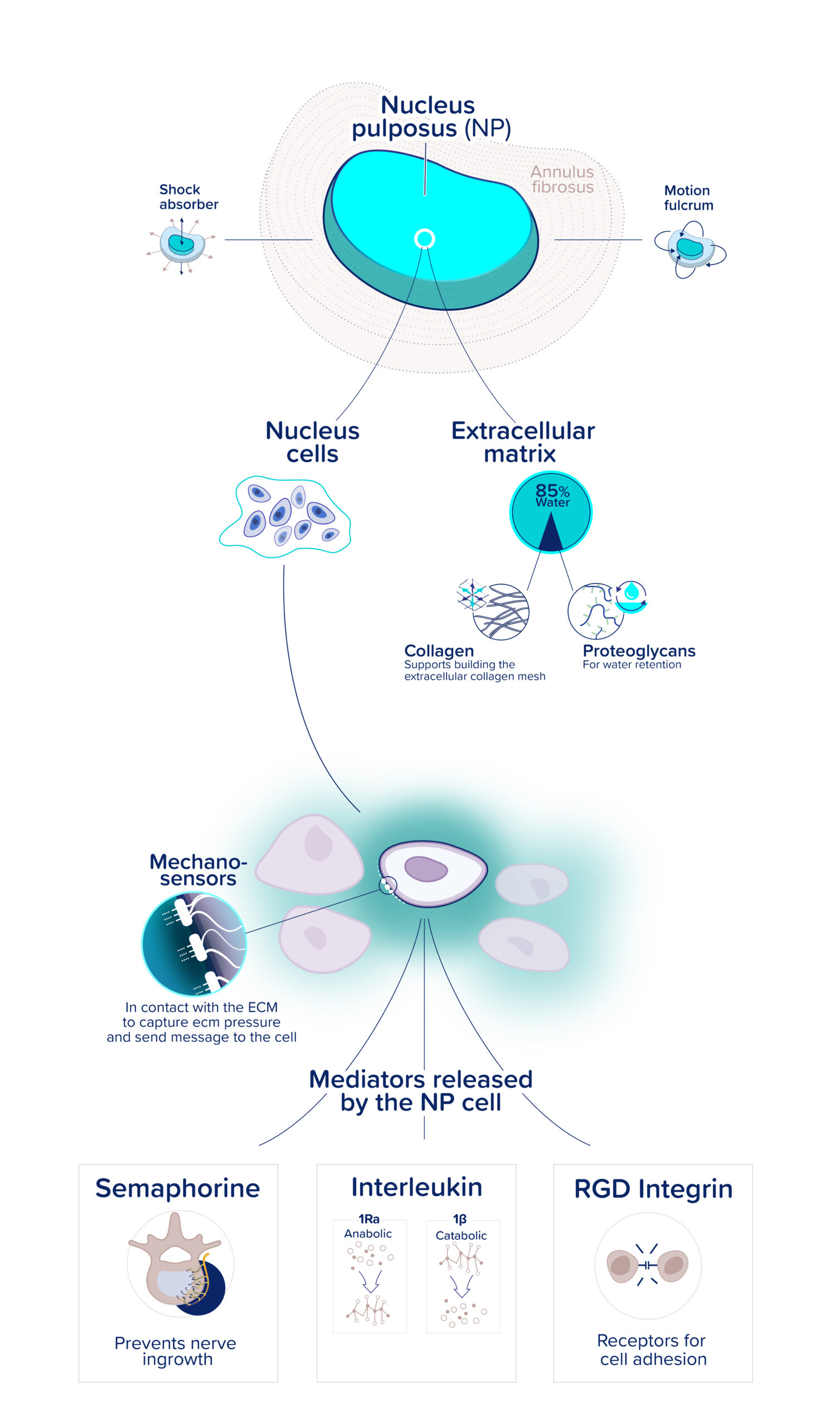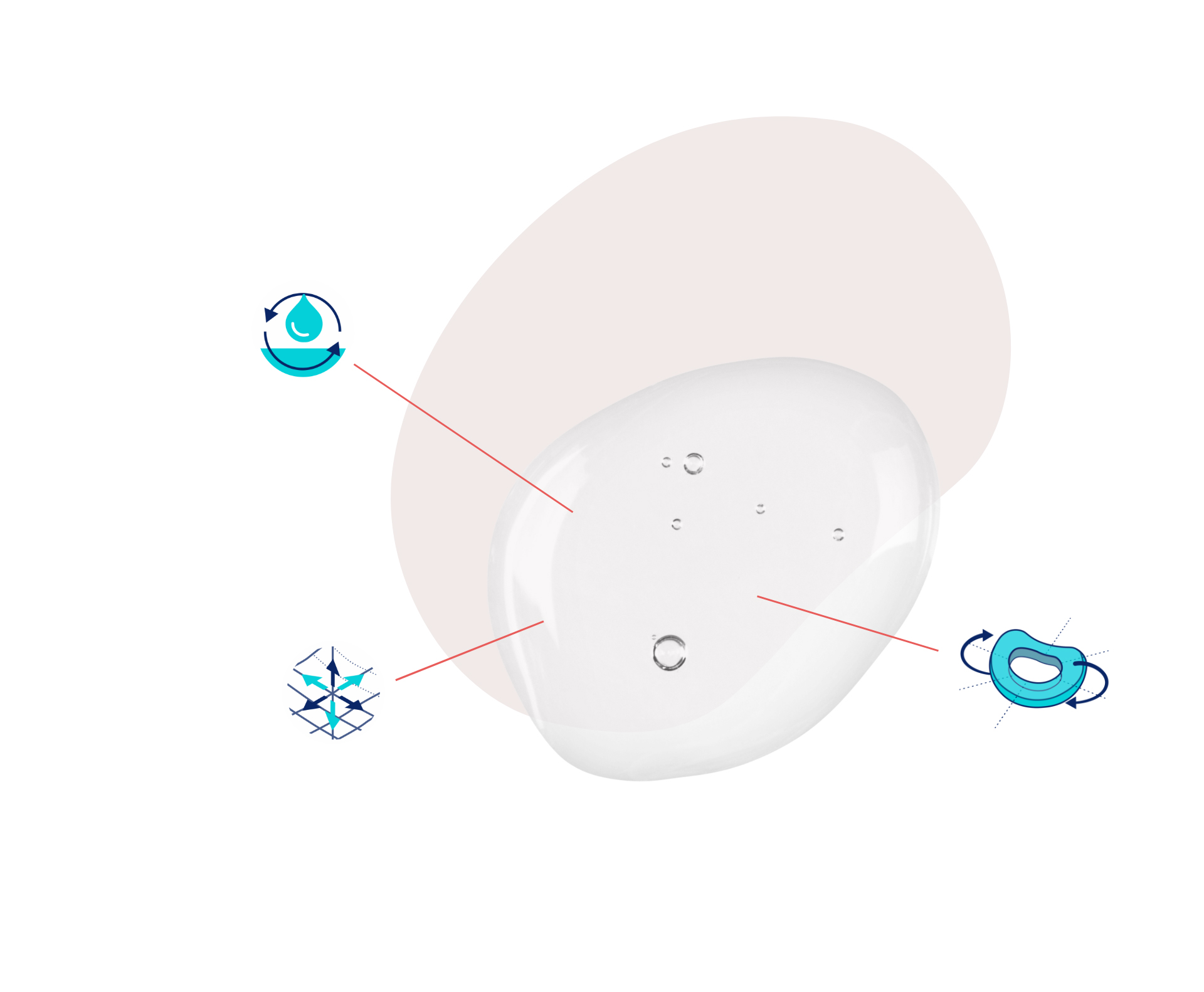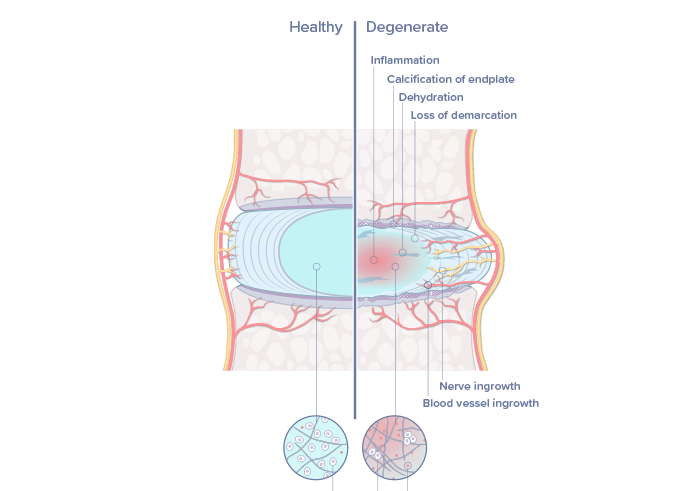Benefits for you
and your patients1,2
and your patients1,2
Current pain relieving therapies for early-mid stage disc degeneration are not satisfactory4
Gelmetix’s novel solution focuses on rehydrating the disc1
DXM addresses the shortcomings of the following existing treatment options4, none of which affect the mechano-biological root cause of pain4:
Disc rehydration is critical for treating early-mid stage degenerative disc disease5
The nucleus pulposus is located at the center of the disc, which is located between two vertebrae. It acts a shock absorber and a fulcrum for motion thanks to its water content6.
Recent advances in the study of the nucleus pulposus help us to understand its functioning and what happens when it doesn’t work well7.
The nucleus is a complex tissue with many active mediators, communicating with its environment and other nucleus cells7.

Collagen
Collagen fibrils in the NP consist primarily of Type II and some Type I, representing 10-20% of the NP dry weight. Collagen fibrils are a few hundred nanometers in diameter and tens of microns in length. The fibrils are structured, but randomly oriented.
Proteoglycans
The most significant biochemical change that occurs in disc degeneration is the loss of proteoglycans in the nucleus pulposus. These large molecules are degraded to smaller fragments that are lost from disc tissue. The consequence is fall in osmotic pressure in the disc matrix and loss of water molecules.
Bio-mechano Sensors
In cells, mechanotransduction is the means by which physical forces, such as stretching, compression and shear stress are translated into biochemical impulses and signals. These result in changes to both cellular and extracellular structures. Even when mechanotransduction-related processes within cells are functioning normally, disturbances in the physical inputs that cells receive from their extracellular environs can then cascade to produce pathological results, such as degeneration of the entire nucleus pulposus tissue.


DXM is composed of a unique hydrogel formulation1

High in water content1
- Brings water to the extracellular matrix
- Restores water content of the nucleus pulposus
- Restores hydrostatic pressure needed by the NP cells to function normally
- Stable under load pressure

Good distribution1
Good distribution within the NP’s extracellular matrix – fills proteoglycan and collagen depleted zones

Well-contained1
Is well-contained by the annulus fibrosus, which is mechanically effective at the early stage of the degenerative process

An introduction to Gelmetix’s
polymer gel technology
polymer gel technology
DXM is a pH-responsive, double cross-linked hydrogel, which is designed to supplement the existing nucleus pulposus1.
DXM seeks to act as a substitute to compensate for the progressive degradation of the proteoglycan matrix of the nucleus1.
DXM has the mechanical properties to restore and maintain disc height and is suitable for restoring close to a normal dynamic pressure environment within the disc. It restores the mechanical conditions with favourable effect on nucleus cell biology that contributes to the relief of pain as it restores the normal function of the nucleus cells1.
DXM fills an unmet gap in the treatment continuum between conservative and surgical methods that has the potential to provide significant pain relief for patients, slow the progression of the disease and reduce the need for more invasive surgical intervention1.
An overview of the medical procedure
An overview of the medical procedure
The Evidence
Based on decades of research. Scientific evidence for Gelmetix’s unique approach to disc rehydration.
Driven by deep understanding of degenerative joints and discs, the inventors saw the potential to link microgel particles together to form injectable, durable and load-bearing gels9.
1Gelmetix data on file (preclinical)
2An injectable nucleus replacement as an adjunct to microdiscectomy: 2 year follow-up in a pilot clinical study. Berlemann U, Schwarzenbach O. Eur Spine J. 2009;18:1706–1712.
3Andersson GB. Epidemiological features of chronic low-back pain. Lancet. 1999;354(9178):581–585. doi:10.1016/S0140-6736(99)01312-4
4Chou R, Côté P, Randhawa K, Torres P, Yu H, Nordin M, et al. The Global Spine Care Initiative: applying evidence-based guidelines on the non-invasive management of back and neck pain to low- and middle-income communities. Eur Spine J. 2018;27(Suppl 6):851–60.
5Pennicooke B, Moriguchi Y, Hussain I, et al. (November 22, 2016) Biological Treatment Approaches for Degenerative Disc Disease: A Review of Clinical Trials and Future Directions. Cureus 8(11): e892. DOI 10.7759/cureus.892
6Walter BA, Korecki CL, Purmessur D, Roughley PJ, Michalek AJ, Iatridis JC. Complex loading affects intervertebral disc mechanics and biology. Osteoarthritis and Cartilage. 2011 Aug;19(8):1011–8
7Tolofari SK, Richardson SM, Freemont AJ, Hoyland JA. Expression of semaphorin 3A and ist receptors in the human intervertebral disc: potential role in regulating neural ingrowth in the degenerate intervertebral disc. Arthritis Res Ther. 2010;12(1):R1
8Richardson SM, Mobasheri A, Freemont AJ, Hoyland JA. Intervertebral disc biology, degeneration and novel tissue engineering and regenerative medicine therapies. Histol Histopathol. 2007 Sep;22(9):1033-41. doi: 10.14670/HH-22.1033. PMID: 17523081.
9Milani AH, Freemont AJ, Hoyland JA, Adlam DJ, Saunders BR. Injectable doubly cross-linked microgels for improving the mechanical properties of degenerated intervertebral discs. Biomacromolecules. 2012 Sep 10;13(9):2793-801. doi: 10.1021/bm3007727. Epub 2012 Aug 30. PMID: 22877136.





